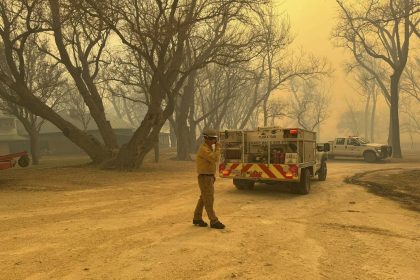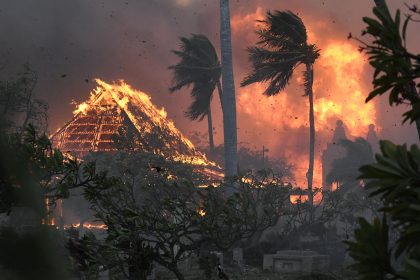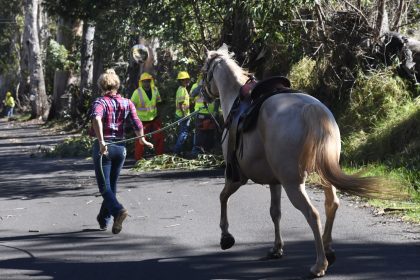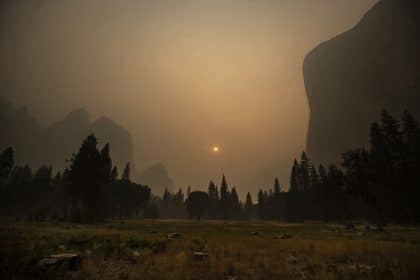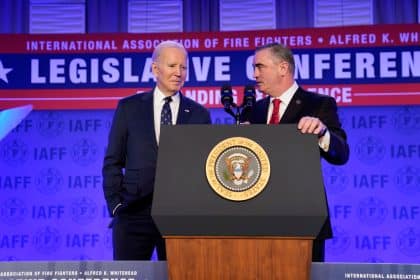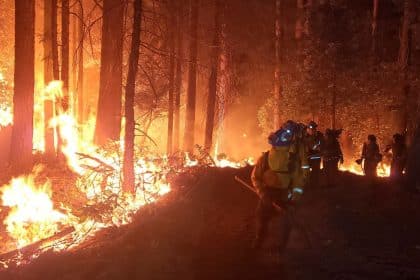Pandemic Precautions Are Protecting Wildfire Fighters — So Far
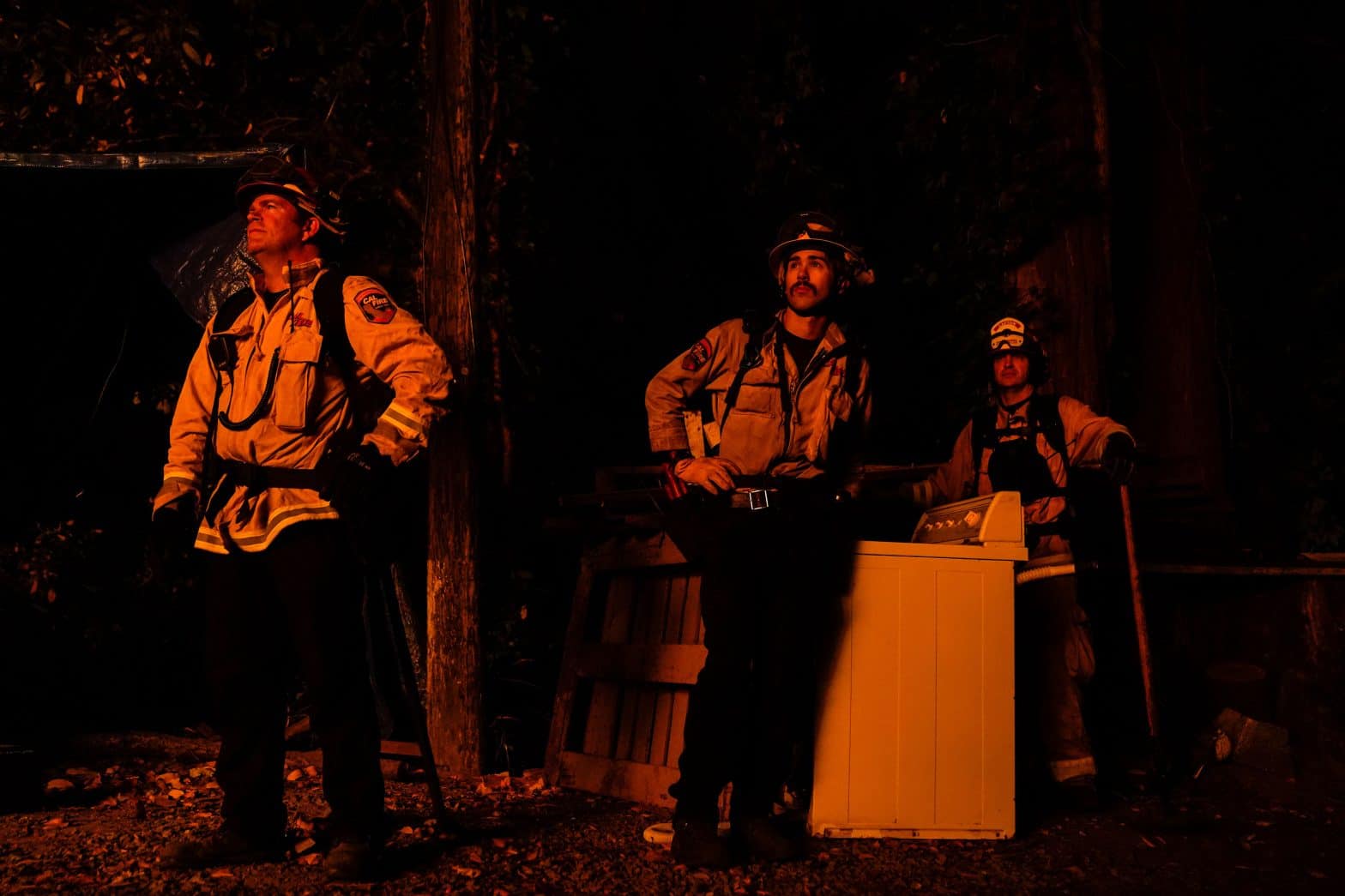
District Chief Paul Duarte’s team, the first to reach the Pine Gulch fire as it began spreading across western Colorado about three weeks ago, put months of planning to the test as they prepared to battle their first major wildfire under pandemic conditions.
First, they were screened for COVID-19 symptoms as the blaze, now the second-largest in state history, ripped through the rough terrain near Grand Junction.
Instead of assembling in a “circus tent,” crews checked in online and received briefings over the radio. Each unit camped together in the field, rather than hundreds of responders establishing a shared base camp. Meals were delivered to each “spike camp,” replacing large communal gatherings.
“The biggest change in the process has really been about the things that attract big groups of people — getting food, supplies, camps and briefings,” said Duarte, an operations section chief with the Colorado Department of Public Safety.
So far, leaders battling blazes across the West say they’re holding their own, despite the pandemic. Some adjustments to COVID-19 are proving more effective than previous tactics. But as more fires erupt in California and elsewhere, responders are bracing for a long battle that will force them to revamp time-tested strategies on the fly.
“We’re building the bridge as we cross it,” said George Geissler, Washington state forester and deputy supervisor for wildfire.
Washington Gov. Jay Inslee, a Democrat, last week declared a state of emergency in response to ongoing wildfires and hot, dry conditions that are likely to lead to more. The declaration allows the state to use aviation resources from the National Guard to help fight fires.
No state has been hit harder than California, where nearly 800,000 acres burned last week, forcing the evacuation of tens of thousands of residents and fouling the air quality in much of the state.
When it comes to on-the-ground firefighting tactics, officials in several states say not much has changed. It’s in the staging areas, where firefighters used to assemble by the hundreds for meals, briefings and camping, that everything looks different.
“I think we’re just as effective as we were before because our tactics haven’t changed,” said Lucas Spelman, battalion chief of southern operations for California Department of Forestry and Fire Protection (CalFire). “But there may be a point where we don’t have the amount of people we’d like to put on those fires.”
CalFire has about 12,000 employees, but only 33 have tested positive for COVID-19 since the pandemic began.
The state is missing workers from inmate crews, because of early releases and COVID-19 outbreaks in prisons. Currently, 106 of California’s 192 inmate crews are staffed. The state usually has more than 2,000 inmates available to fight fires, but that number has dropped by more than 500 this year.
California has about 7,000 firefighters deployed. Gov. Gavin Newsom, a Democrat, announced in July that the state would hire more than 800 temporary firefighters, and most of those workers now have joined the ranks.
Like many states, California’s strategy this year involves an aggressive early response, trying to squelch fires quickly in the hopes that will prevent some from becoming large blazes. The fewer massive fires, the fewer large camps will be required, lessening COVID-19 risk.
“Initial attack is happening much sooner,” said Brad Alexander, spokesperson for the California Governor’s Office of Emergency Services, which oversees and coordinates with local response agencies. “Hopefully we can cut off these fire events a lot earlier.”
Alexander said the state was fortunate that COVID-19 hit earlier in the year, giving officials time to prepare for fire season under new conditions. Another silver lining is that the pandemic has created strong lines of communication between state agencies and county leaders who respond to emergencies. But as more fires spring up, California knows it will continue to be tested.
“With these lightning storms, there’s tons of fires burning right now and it’s starting to impact our ability to deal with them,” CalFire’s Spelman said. “It’s going to be a long fire season.”
New ways of working prompted by the pandemic have some upsides.
In Colorado, firefighters have found that assembling small camps in the field, as opposed to regrouping en masse further from the fire line each evening, has saved hours of travel and briefing time each day. Food and supplies are delivered to each spike camp daily.
“We gain a lot by keeping people spiked close to where they’re working,” Duarte said. “There’s some opportunities we’re going to find due to this and become more efficient in the long run. It’s been pretty astonishing how well it’s worked up to this point.”
The state also has used more aviation resources to hit fires early, hoping to prevent massive blazes that require a large assembly of firefighters.
“We’re hitting fires that are small and trying to keep them small,” said Phil Daniels, deputy chief of Colorado’s Wildland Fire Management Section. “Our number of large fires is lower than it could have been.”
Oregon and Washington likewise have deployed more helicopters and planes to fight fires this year. Geissler, the state forester, said the strategy has been successful, but noted attacking fires from the air creates additional risk. Aviation units also are very expensive, but some state officials believe they could be more cost-effective in the long run if they prevent large fires from spreading across the landscape.
“There’s an argument that suppressing big fires could save money,” Geissler said. “If we had a lot more aircraft, we could keep the fires small all the time. We’re learning a lot this year about what the risk-reward challenge is.”
Some firefighters in Washington have been housed in nearby hotels instead of camps, which crews have welcomed and which could become a long-term strategy. Even before COVID-19, it was common for other illnesses to spread widely in fire camps, a phenomenon known as “camp crud.” The spread-out approach to this year’s camps could be a model for avoiding that issue in the future, Geissler said.
At Oregon’s Mosier Creek fire, the state’s first large-scale deployment this year, fire camps were kept off-limits to visitors as crews staged earlier this month. Crews camped in modules of about 10 people, and everything from meals to showers was reconfigured to limit exposure. The state has so far avoided any outbreaks among its teams.
So far, leaders in the West say they’ve avoided their worst nightmare: a COVID-19 outbreak that takes hundreds of firefighters out of commission. Colorado has not had any of its firefighters test positive, and Washington has had only a handful of cases, including one in which 14 firefighters had to quarantine after a potential exposure.
“It’s not the hundreds and hundreds of cases that we were concerned about early on,” Geissler said. “To date, everything has been kept manageable.”
He added that state and county health officials have worked to turn around firefighters’ COVID-19 test results quickly, but if there are delays later in the season, it could create problems for the state.
Colorado has conducted mass testing for firefighters when they leave camp, seeking to ensure they don’t bring the virus back to their home communities.
While COVID-19 has not yet decimated states’ wildfire response, officials know they’re not close to being done with wildfire season or the pandemic.
Jim Gersbach, public information officer for the Oregon Department of Forestry, said the state is not counting on receiving as much help from out-of-state crews or Canadian partners this year because of the pandemic.
“The real test is this month, because we now have a lot of fires burning simultaneously, and there’s a lot of demand on resources across the country,” he said.
As long as states can keep their crews from getting infected, they say they can be just as effective as ever.
“The firefighting portion of it hasn’t changed that much,” CalFire’s Spelman said.
———
©2020 Stateline.org
Distributed by Tribune Content Agency, LLC.

















